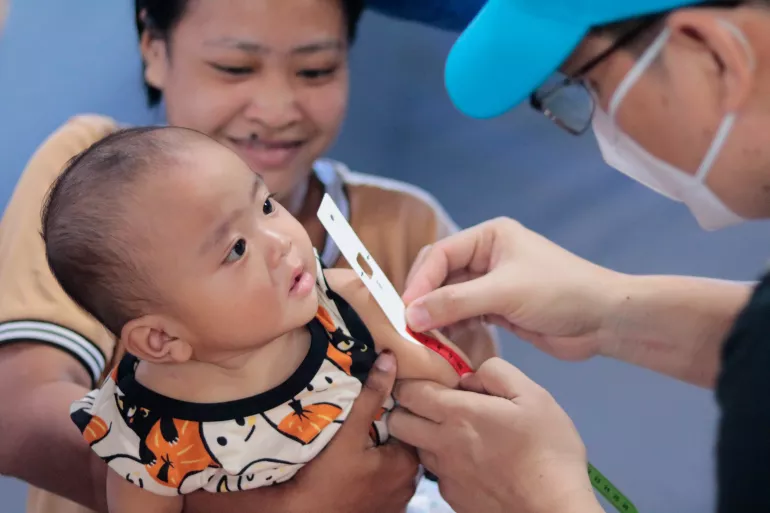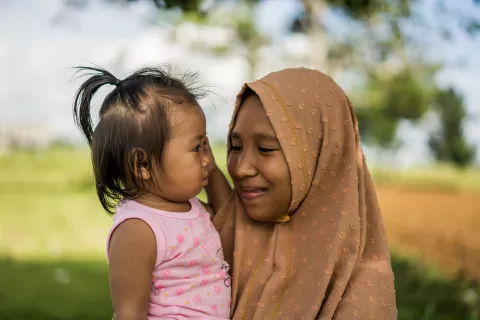When you meet a child who is suffering from wasting, as I have, you never forget it.
I have met children who are unable to eat. I have met children who are so weak that they cannot find energy to play. And I have met children suffering from illnesses like pneumonia, their bodies too weak to fight it.
Wasting is the most immediate, visible, and life-threatening form of malnutrition. Globally every year, an estimated one million children lose their lives due to wasting. In East Asia and the Pacific alone, there are 4.9 million children with wasting, including 2.1 million children with severe wasting. Yet, this emergency for children remains overlooked.
Alarmingly, children with severe wasting are up to 11 times more likely to die than children with no wasting. This is because severe wasting turns common childhood illnesses into fatal diseases. Children who are severely wasted succumb to diseases because their bodies have virtually no protection against infections.
We need to talk more about childhood wasting so that parents and communities know how to recognize its symptoms and can seek medical support, if needed.
Wasting is caused when growing children do not get enough of the foods their bodies need, or when children repeatedly get ill and do not get adequate nutrition during their illnesses – resulting in sudden weight loss. Sometimes wasting also starts in the womb, if a pregnant woman does not get adequate nutrition during pregnancy.
There’s a common misconception that wasting only occurs in emergencies, when there are floods, droughts, and conflicts. But only about a quarter of children with severe wasting globally live in such contexts. In reality, severe wasting is most common among young girls and boys who live in the poorest and most neglected rural and even urban areas.
While overall living standards for many families in East Asia and the Pacific may have improved in recent decades, some of these vulnerable children and families continue to go unnoticed and unattended. Furthermore, in some communities, malnutrition has a lot of stigmas attached to it. Families are sometimes hesitant to seek help due to social shame, and this can further worsen the condition of children who need treatment.
Because of all this, it is critical that parents and communities know how to prevent or manage wasting and seek medical treatment on time.
Prevention is better than cure
The good news is that wasting is perfectly preventable. The period of pregnancy and the first year of a child’s life are critical in preventing wasting. There are quite a few things that can be done to prevent wasting:
- Ensure nutritious diets and antenatal care services for women during pregnancy. These are key for healthy fetal growth and development, and they reduce the risk of the child being born with a low birth weight, which increases the risk of wasting.
- Make sure children are exclusively breastfed for the first six months and continue breastfeeding up to 2 years of age and beyond.
- Starting at six months, provide nutritious and diverse first foods with different textures and tastes, such as fruits, vegetables, and animal-source foods like eggs, fish, and dairy.
- Maintain good hygiene when preparing food to prevent foodborne illnesses, which can lead to malnutrition. Wash hands, fruits, and vegetables thoroughly.
- Seek regular medical care including prompt treatment of illness, routine vaccinations and growth monitoring.
Our work with governments and partners has always been guided by the principle of preventing wasting first. We know how much more challenging it is to track children with wasting and get the right treatment and support for them, given that most of them live in extremely tough circumstances, in hard-to-reach communities.
But when prevention fails, children with severe wasting need immediate medical attention. Fortunately, most children with severe wasting can be treated as outpatients with medication, nutritional treatment, and psychosocial support. This treatment needs to be provided by a skilled health worker who can provide care until a child recovers.
Care for Children with Wasting
UNICEF has been working with governments in East Asia and the Pacific to include early identification and treatment of childhood wasting as essential services in primary health care. We’ve also been advocating with countries to produce ready-to-use therapeutic food (RUTF), the main life-saving treatment for children with wasting. Some countries even have domestic production of local RUTF – for example, using fish powder instead of milk.
But the major challenge remains lack of awareness. Even frontline workers and partners do not always have the skills and knowledge needed to treat wasting. That’s why UNICEF has just launched a free course, Care for Children with Wasting in East Asia and the Pacific, open to all who wish to know more.
We know prevention is always better than cure. And when we all know how to prevent wasting, we will be working towards a world where no child has to suffer from this life-threatening condition.
Asia Times Interview: Wasting: An overlooked emergency for the youngest children






